The script ‘Recall’ is one with mystery, violence and darkness. The story revolves around a young man Jack, and how he becomes to know a distressed girl named Freya, the pair go from strangers to partners in an attempt to get away from a group of masked gang members although their attempts ultimately leads to both of their deaths all due to Jacks wrongdoing in past life. I chose to edit my film using the style of the French New Wave movement, this is ‘a movement in filmmaking that started in France in the 1950s, characterised by loosely structured plots and unconventional photographic techniques.’ (TheFreeDictionary.com, 2015). I decided on this movement because in my research, I thought the general characteristics found in films from this movement would work well with the original script and also fits with our method of production. These include, low budget/restrictions, shoot on location and natural sound, editing techniques (the jump cut) and handheld cameras.
“The New Wave dramatically changed filmmaking inside and outside of France by encouraging new styles, themes, and modes of production throughout the world.” (Neupert, 2007), As stated by Neupert and others, films in this movement have broken the rules of continuity and don’t follow traditional methods of filmmaking, this is so audiences are reminded they are watching a film. This gave me some room to play around with the footage and not be restricted to by the traditional conventions.
The French New Wave movement came about after World War Two and at that time there were film subsidies put in place for new productions and filmmaking equipment, this meant that directors had access to light weight, handheld cameras capable of recording high quality footage on location. “These breakthroughs meant directors no longer needed a studio to make a film, as real locations provided free, authentic backdrops.” (Wiegand, 2001). In terms of our production we used similar methods of production, a large majority of footage was filmed on location, we used friends as cast members, we used natural lighting (other than the final scene) and a lot of shots are handheld. This meant that when it came to make my edit look like French New Wave, the motions were already in place.
The rise in hand held cameras created shaky and unstable shots but it allowed directors to shoot long tracking and establishing shots, this is due to filmmakers taking advantage of the new technology now available to them.(Characteristics of French New Wave Films, 2012). My opening shot is a 25 second take of James walking towards the camera while Freya is sat on the bench, this was to start Recall with a natural and casual atmosphere, ‘the calm before the storm’. Although the majority of French New Wave films are black and white due to the limited technology available and not a choice by the directors/editors, I decided to edit my film to be black and white. I did this to emphasise the French New Wave movement and also to continue the theme of darkness already written in the script.
The use of jump cuts is very prominent in the editing of French New Wave films, this can be seen in Jean-Luc Goddard’s car scene in Breathless (1960). The jump cut emphasises the notion of discontinuity seen in French New Wave, it allows audiences to remember they are watching a constructed film. “The effect of jump cuts suggests to the viewer that actions are not represented in a film, they are created by authorial will, and their pace depends not on how they occur in reality, but what emotional effect the auteur wishes to exercise on the viewer.” (Kovács, 2007). In Recall, in the scene where James is held at knifepoint there is a series of jump cuts to make the audience feel the distress and uncomfortable setting that James is in. Again as Freya barges into James’ flat the pace of editing increases and there are more jump cuts, I did this to connote the urgency of the matter that is currently happening.
The ending scene in Recall features Freya tied up and James coming to find her but then getting himself into situation where his life is threatened. In this scene the location is a dark basement where we used an artificial LED light to create high contrast and shadows. This aspect of the film does not reflect the French New Wave movement in terms of methods and location, however there is an element of discontinuity. In the scene both gang members are armed with knives but at the end I decided to add in a sound effect of a gun shot even though the audience never see a gun, throughout the film the audience is mostly aware of what is going on until the very end. The scene ends with Freya asking “Who’s Beth?” and Danny screaming at her to shut up, it goes to black and then the audience hears a gunshot and the beginning music starts to play, this was to add enigma to the film. The audience is left asking “Who is Beth?” “Who fired the gun?” “Was there a third gang member?” “What happens next?” and so on. This was an alternate ending to the original script where Freya and James were both killed by Danny and Pete using the knifes but due to our actor Jack becoming ill we couldn’t film the final murder scenes so I made the decision to have this enigmatic ending.
In terms of how effective my final edit is, I believe that the French New Wave movement does work for the narrative and the choices I have made emphasise that. The soft use of jump cuts affects the emotion of the audience and creates discomfort for them that the characters in the film are experiencing. The discontinuity and gaps in narrative has the same nature as French New Wave in that it reminds the audience they are watching a film that has been creatively structured by a group of individuals to go against traditional conventions.
Bibliography
Breathless. (1960). [film] France: Jean-Luc Godard
http://makeawave-frenchnewwave.blogspot.co.uk/2012/08/characteristics-of-french-new-wave-films.html [Accessed 13 May 2015].
Kovács, A. (2007). Screening modernism. Chicago: University of Chicago Press.
Neupert, R. (2007). A history of the French new wave cinema. Madison, Wis.: University of Wisconsin Press.
TheFreeDictionary.com, (2015). French New Wave. [online] Available at: http://www.thefreedictionary.com/French+New+Wave [Accessed 13 May 2015].
Wiegand, C. (2001). French new wave. Harpenden: Pocket Essentials.
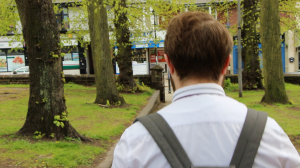
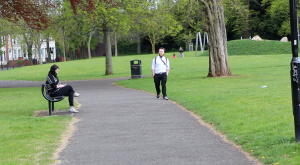
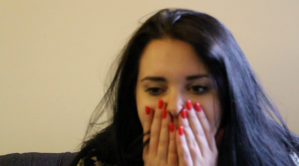
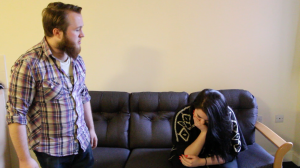
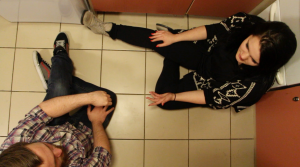
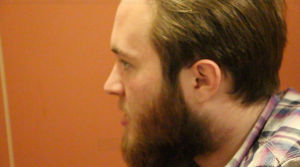
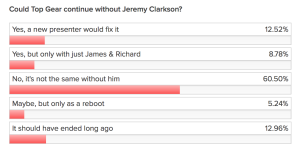 ng it has been the three of them. Digital Spy conducted a poll asking whether the show should continue without Clarkson, 60.50% said that a Clarkson-less show would not work. (Alexander, 2015) This again indicates how audiences feel.
ng it has been the three of them. Digital Spy conducted a poll asking whether the show should continue without Clarkson, 60.50% said that a Clarkson-less show would not work. (Alexander, 2015) This again indicates how audiences feel.
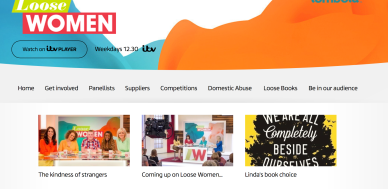 n website features a lot of videos such as clips from the shows or extra clips based on what has been discussed in the show, also information on what is coming up on the show. The bar at the top allows viewers to go to different sections on the website. For the Loose Women site the viewer can look at the presenters which are different each day but are they same group of women, enter competitions, and find out how to be in the audience. Upon clicking on each title there is the same blog style running throughout the whole website, also what is quite different is the ‘Loose Books’ header where viewers can look what the presenters recommend for reading and also look at tweets from audience members.
n website features a lot of videos such as clips from the shows or extra clips based on what has been discussed in the show, also information on what is coming up on the show. The bar at the top allows viewers to go to different sections on the website. For the Loose Women site the viewer can look at the presenters which are different each day but are they same group of women, enter competitions, and find out how to be in the audience. Upon clicking on each title there is the same blog style running throughout the whole website, also what is quite different is the ‘Loose Books’ header where viewers can look what the presenters recommend for reading and also look at tweets from audience members.
